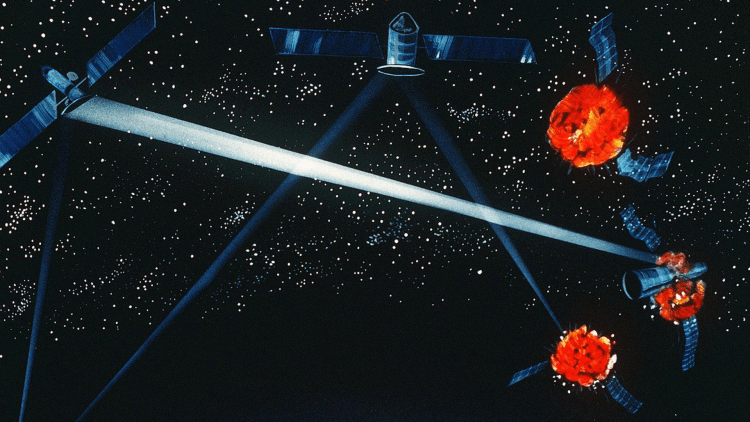Imagine it’s 1983. The Cold War is in full swing, the hair is big, and the threat of nuclear war hangs heavy in the air.
Then, in a televised address, President Ronald Reagan threw a curveball: a plan to shoot down incoming missiles with lasers—a real-life “Star Wars” defense system.
Buckle up because we’re diving into the story of the Strategic Defense Initiative (SDI), also known as Reagan’s “Star Wars” program.
Nuclear Nightmares and the MAD Dance
The world in 1983 wasn’t exactly sunshine and rainbows.
The US and the Soviet Union were locked in a tense standoff, each side stockpiling enough nuclear weapons to wipe each other off the map several times over.
It was a scary time, with the doctrine of “Mutually Assured Destruction” (MAD) basically meaning any major attack would result in everyone losing big time.
That is not exactly a comforting thought.
Reagan Says “No Way” to MAD
Enter Ronald Reagan, a staunch anti-communist who wasn’t exactly a fan of the whole “everyone dies” plan.
He believed there had to be a better way to defend against nuclear threats.
So, in a televised speech on March 23, 1983, that had everyone buzzing, he proposed a revolutionary new defense system: the SDI.
The “Star Wars” Nickname Takes Off
The media, with their knack for catchy nicknames, seized on the futuristic nature of SDI and its resemblance to the popular science fiction franchise.
Just a few years earlier, in 1977, “Star Wars,” created by George Lucas, had exploded onto the scene, captivating audiences with its epic space battles and laser-wielding heroes.
The parallels were undeniable – a high-tech defense system utilizing directed-energy weapons to blast incoming threats out of the sky.
News outlets gleefully adopted the nickname, splashing headlines like “Reagan Proposes ‘Star Wars’ Defense Shield” and “Can Lasers Really Stop Missiles? The ‘Star Wars’ Debate Begins.”
The public readily embraced the term as it was far more evocative than the technical jargon of “Strategic Defense Initiative,” and it captured the imagination of a generation raised on sci-fi films and pulp novels.
However, the nickname wasn’t universally loved.
Critics argued it trivialized the seriousness of the proposal and downplayed the immense logistical and technological challenges involved. They worried it painted an unrealistic picture of SDI’s capabilities, suggesting a near-instantaneous defense system when the reality was far more complex.
Despite the criticism, the “Star Wars” nickname stuck.
It became shorthand for the program, a pop culture reference point woven into discussions about nuclear deterrence and Cold War tensions.
Whether used seriously or with a touch of skepticism, the nickname ensured SDI remained firmly in the public consciousness.
Shooting Down Missiles with Lasers (Maybe)
SDI envisioned a multi-layered defense system.
Think space-based lasers that could fry incoming missiles with focused beams of light, particle beams that sounded like something out of a Star Trek episode, and even ground-based missiles that could intercept enemy nukes before they reached their targets.
It was ambitious, to say the least.
An artist’s rendition of the 1984 SDI concept, where a laser-equipped satellite fired on another. (Image source: Wikimedia Commons)
But Was It Actually Possible?
Here’s the thing: the technology behind SDI was, well, let’s just say, way too ambitious for its time.
Directed-energy weapons like lasers were still in their early stages, and the sheer logistics of defending such a vast area with pinpoint accuracy seemed mind-boggling.
Critics scoffed, calling it impractical, insanely expensive, and potentially even dangerous as it might provoke an arms race with the Soviets.
Did It Work? Not Exactly…
SDI never achieved its initial goal of creating an impenetrable shield against nuclear attack.
The technology just wasn’t there yet, and the costs were astronomical.
However, the research and development spurred significant advancements in laser and missile technology that have applications even today.
The Legacy of Star Wars
SDI had a significant impact on the Cold War. It played a role in later arms control talks with the Soviets, and some elements of its research contributed to the development of modern missile defense systems currently deployed by the US.
Here’s a deeper look at the lasting impacts of this ambitious program:
Technological Advancements
SDI, despite its shortcomings, served as a massive catalyst for technological advancements.
Research and development poured into lasers, missile guidance systems, and high-powered computing. These advancements had a ripple effect, influencing fields beyond military applications.
Laser technology has seen significant progress in medical, manufacturing, and communications applications.
The guidance systems developed for SDI laid the groundwork for more precise missile defense systems deployed today.
A Shift in Cold War Thinking
The very idea of a defensive shield challenged the prevailing doctrine of MAD.
While SDI ultimately didn’t dismantle nuclear arsenals, it opened doors for discussions about alternative defense strategies and eventually played a role in later arms control talks with the Soviets.
The Seeds of Modern Missile Defense
Elements of SDI research directly contributed to the development of modern missile defense systems currently operational in the US.
While not a perfect shield, these systems are designed to intercept ballistic missiles in the late stages of their flight path.
Lockheed’s antiballistic missile (ABM) test vehicle for the US Army’s Homing Overlay Experiment (Image source: Wikimedia Commons)
A Debate That Endures
The debate surrounding missile defense continues today.
Proponents argue it’s crucial for deterring threats from rogue nations or accidental launches.
Critics raise concerns about effectiveness, cost, and the potential for an arms race with other nuclear powers.
A Reminder of Sci-Fi’s Influence
SDI reminds us of the ongoing interplay between science fiction and scientific progress.
The program’s futuristic vision, inspired by popular sci-fi films, may have yet to be fully realized, but it pushed the boundaries of what was thought possible.
The Debate Continues
The debate surrounding missile defense continues to this day.
Proponents argue it’s essential to counter potential threats from rogue nations, while critics question its effectiveness and cost.
SDI serves as a reminder of the ongoing quest for security in an age of nuclear weapons and the ever-present challenge of turning futuristic visions into practical realities.
So, while Reagan’s dream of a real-life Star Wars shield never quite materialized, SDI’s legacy lives on in the advancements it helped spark and the ongoing conversation about defending ourselves in a world with the potential for nuclear devastation.



